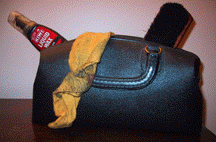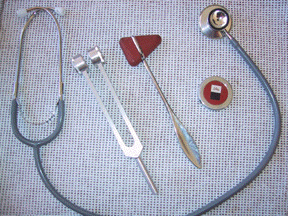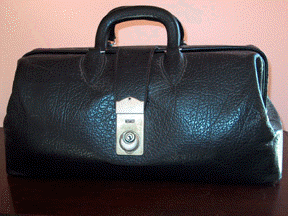Paraphernalia
Michael A. Ingall, M.D.

To celebrate our inauguration into the world of patient care, we were given doctors' bags. They were a bit skimpy, made of leatherette, not leather, but they were big enough to handle all the equipment we had. I still have mine today and use it for a shoeshine kit.
 And, so that we could enjoy the fantasy, inside the bags were three instruments: a genuine stethoscope, a rubber reflex hammer shaped like a tomahawk, and a tuning fork to test hearing and vibratory sense (one struck the fork against one's hand and then held the non-vibrating end of the fork against the patient's shinbone. "Can you feel that?" one asked, as the patient howled in discomfort. All three instruments had stamped on them in bright red script: Lilly. I was in love.
And, so that we could enjoy the fantasy, inside the bags were three instruments: a genuine stethoscope, a rubber reflex hammer shaped like a tomahawk, and a tuning fork to test hearing and vibratory sense (one struck the fork against one's hand and then held the non-vibrating end of the fork against the patient's shinbone. "Can you feel that?" one asked, as the patient howled in discomfort. All three instruments had stamped on them in bright red script: Lilly. I was in love.
 When we were graduated, Lilly gave us a handsome heavyweight cobbled leather doctor's bag, with our names embossed in gold, with an M.D. after the name. I have no use for it today, but throwing it out would be like throwing out the Congressional Medal of Honor.
When we were graduated, Lilly gave us a handsome heavyweight cobbled leather doctor's bag, with our names embossed in gold, with an M.D. after the name. I have no use for it today, but throwing it out would be like throwing out the Congressional Medal of Honor.
My father always welcomed pharmaceutical representatives to his office. They gave him samples which he distributed to his indigent patients. When I served at the Naval Hospital at Quonset Point, Rhode Island, all of us closed up shop within 10 minutes when the pharmaceutical rep would holler down the corridor, "Who's for Twin Oaks?" Joining a bunch of pharmaceutical reps for Rhode Island's best lunch seemed like the thing to do at the time. There was no attempt to bribe us or get us to use their medicines. We were just colleagues, enjoying each other's company.
Since that time a new movement among physicians has arisen, spurred by young physicians in medical school and residency. It's called "No Free Lunch," and it urges doctors not to accept lunches, pens, trinkets, doctor bags, hammers, tuning forks, etc., from pharmaceutical companies. "They put food in our mouths, and the message, although never spoken, is clear."
Six months ago, I sold my house for a nice sum of money. It's been sitting in the savings bank getting 3% interest. Dubya and all the gang are going to take us to war with Saddam. Is it not time to reinvest in the stock market? After 9/11, is it not a time for healing? Should I buy Lilly?